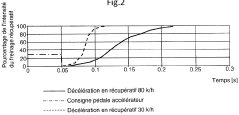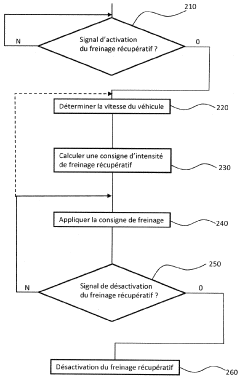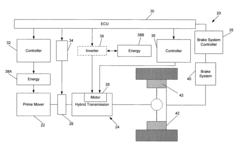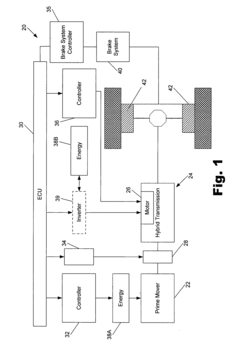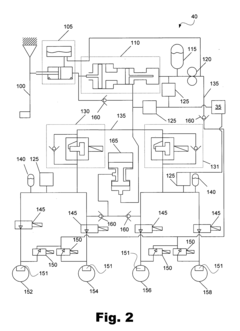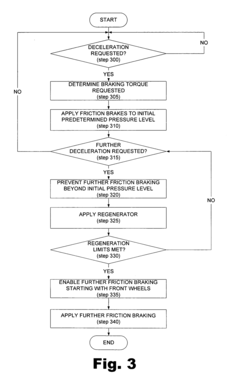Comparative Challenges in Regenerative Braking for Urban and Rural Systems
AUG 15, 20259 MIN READ
Generate Your Research Report Instantly with AI Agent
Patsnap Eureka helps you evaluate technical feasibility & market potential.
Regenerative Braking Evolution and Objectives
Regenerative braking has evolved significantly since its inception in the early 20th century. Initially developed for electric vehicles, this technology has undergone substantial improvements and adaptations to meet the diverse needs of urban and rural transportation systems. The primary objective of regenerative braking is to recover and store energy that would otherwise be lost as heat during conventional braking, thereby improving overall vehicle efficiency and reducing energy consumption.
In urban environments, regenerative braking systems have been refined to capitalize on the frequent stop-and-go traffic patterns. The evolution of this technology in cities has focused on maximizing energy recovery during short, repetitive braking events. Urban systems have seen advancements in power electronics and energy storage technologies, enabling more efficient capture and utilization of recovered energy. The objectives for urban regenerative braking include reducing fuel consumption, minimizing wear on conventional brake components, and contributing to improved air quality through reduced emissions.
Rural applications of regenerative braking, on the other hand, have faced unique challenges and objectives. The evolution of these systems has been driven by the need to adapt to longer driving distances, higher speeds, and less frequent braking events. In rural settings, the focus has been on developing regenerative braking systems that can effectively capture energy during occasional, high-speed deceleration events. The objectives for rural regenerative braking include extending vehicle range, improving overall energy efficiency on long journeys, and reducing the environmental impact of transportation in less densely populated areas.
The technological progression of regenerative braking has seen a shift from simple resistive braking systems to more sophisticated electromagnetic and hydraulic solutions. This evolution has been marked by the integration of advanced control algorithms, which optimize energy recovery based on vehicle speed, road conditions, and driver behavior. The development of hybrid and fully electric powertrains has further accelerated the advancement of regenerative braking, as these vehicles rely heavily on energy recovery to extend their range and improve efficiency.
Looking ahead, the objectives for regenerative braking technology continue to evolve. There is a growing emphasis on developing adaptive systems that can seamlessly transition between urban and rural driving conditions, maximizing energy recovery in both scenarios. Future goals include improving the integration of regenerative braking with autonomous driving technologies, enhancing the user experience through smoother braking transitions, and further increasing the percentage of energy that can be recovered during deceleration events.
In urban environments, regenerative braking systems have been refined to capitalize on the frequent stop-and-go traffic patterns. The evolution of this technology in cities has focused on maximizing energy recovery during short, repetitive braking events. Urban systems have seen advancements in power electronics and energy storage technologies, enabling more efficient capture and utilization of recovered energy. The objectives for urban regenerative braking include reducing fuel consumption, minimizing wear on conventional brake components, and contributing to improved air quality through reduced emissions.
Rural applications of regenerative braking, on the other hand, have faced unique challenges and objectives. The evolution of these systems has been driven by the need to adapt to longer driving distances, higher speeds, and less frequent braking events. In rural settings, the focus has been on developing regenerative braking systems that can effectively capture energy during occasional, high-speed deceleration events. The objectives for rural regenerative braking include extending vehicle range, improving overall energy efficiency on long journeys, and reducing the environmental impact of transportation in less densely populated areas.
The technological progression of regenerative braking has seen a shift from simple resistive braking systems to more sophisticated electromagnetic and hydraulic solutions. This evolution has been marked by the integration of advanced control algorithms, which optimize energy recovery based on vehicle speed, road conditions, and driver behavior. The development of hybrid and fully electric powertrains has further accelerated the advancement of regenerative braking, as these vehicles rely heavily on energy recovery to extend their range and improve efficiency.
Looking ahead, the objectives for regenerative braking technology continue to evolve. There is a growing emphasis on developing adaptive systems that can seamlessly transition between urban and rural driving conditions, maximizing energy recovery in both scenarios. Future goals include improving the integration of regenerative braking with autonomous driving technologies, enhancing the user experience through smoother braking transitions, and further increasing the percentage of energy that can be recovered during deceleration events.
Urban vs Rural Market Demand Analysis
The market demand for regenerative braking systems in urban and rural environments presents distinct characteristics and challenges. In urban areas, the demand for regenerative braking technology is significantly higher due to the frequent stop-and-go traffic patterns. Cities with high population density and congested roads create an ideal environment for maximizing the benefits of energy recovery during braking. This has led to a strong market pull for regenerative braking systems in urban public transportation, particularly in buses and light rail systems.
Urban markets also show a growing demand for regenerative braking in personal vehicles, especially hybrid and electric cars. The increasing awareness of environmental issues and stringent emission regulations in cities have further boosted this demand. Many urban dwellers are willing to pay a premium for vehicles equipped with regenerative braking technology, perceiving it as a way to reduce their carbon footprint and save on fuel costs.
In contrast, rural markets exhibit a different demand profile for regenerative braking systems. The less frequent braking events and longer stretches of continuous driving in rural areas reduce the immediate benefits of regenerative braking. However, there is a niche market for this technology in rural settings, particularly in agricultural and construction equipment. These heavy-duty vehicles can benefit from energy recovery during operations that involve frequent stops or changes in direction.
The market size for regenerative braking systems in urban areas is substantially larger than in rural regions. This disparity is reflected in the investment patterns of automotive manufacturers and technology companies, which tend to focus their research and development efforts on urban applications. However, this urban-centric approach may be overlooking potential opportunities in rural markets.
An emerging trend in both urban and rural markets is the integration of regenerative braking with advanced driver assistance systems (ADAS) and autonomous vehicle technologies. This integration promises to optimize energy recovery by predicting braking events and adjusting the system's performance accordingly. In urban environments, this could lead to even greater energy savings, while in rural areas, it could help overcome some of the limitations posed by less frequent braking opportunities.
The adoption rate of regenerative braking technology also differs between urban and rural markets. Urban areas, with their higher concentration of early adopters and greater exposure to new technologies, tend to embrace regenerative braking more quickly. Rural markets, on the other hand, often show a slower adoption rate, partly due to the longer vehicle replacement cycles and the perception that the technology may not provide significant benefits in rural driving conditions.
Urban markets also show a growing demand for regenerative braking in personal vehicles, especially hybrid and electric cars. The increasing awareness of environmental issues and stringent emission regulations in cities have further boosted this demand. Many urban dwellers are willing to pay a premium for vehicles equipped with regenerative braking technology, perceiving it as a way to reduce their carbon footprint and save on fuel costs.
In contrast, rural markets exhibit a different demand profile for regenerative braking systems. The less frequent braking events and longer stretches of continuous driving in rural areas reduce the immediate benefits of regenerative braking. However, there is a niche market for this technology in rural settings, particularly in agricultural and construction equipment. These heavy-duty vehicles can benefit from energy recovery during operations that involve frequent stops or changes in direction.
The market size for regenerative braking systems in urban areas is substantially larger than in rural regions. This disparity is reflected in the investment patterns of automotive manufacturers and technology companies, which tend to focus their research and development efforts on urban applications. However, this urban-centric approach may be overlooking potential opportunities in rural markets.
An emerging trend in both urban and rural markets is the integration of regenerative braking with advanced driver assistance systems (ADAS) and autonomous vehicle technologies. This integration promises to optimize energy recovery by predicting braking events and adjusting the system's performance accordingly. In urban environments, this could lead to even greater energy savings, while in rural areas, it could help overcome some of the limitations posed by less frequent braking opportunities.
The adoption rate of regenerative braking technology also differs between urban and rural markets. Urban areas, with their higher concentration of early adopters and greater exposure to new technologies, tend to embrace regenerative braking more quickly. Rural markets, on the other hand, often show a slower adoption rate, partly due to the longer vehicle replacement cycles and the perception that the technology may not provide significant benefits in rural driving conditions.
Technical Hurdles in Urban and Rural Environments
The implementation of regenerative braking systems in urban and rural environments presents distinct technical challenges due to the varying operational conditions and infrastructure disparities. In urban settings, the frequent stop-and-start traffic patterns provide ample opportunities for energy recovery, but also demand rapid and efficient energy conversion and storage systems. The high-density traffic and limited space in cities necessitate compact and lightweight regenerative braking components that can withstand frequent use without compromising performance or safety.
Conversely, rural environments pose different hurdles for regenerative braking technology. The longer distances between stops and generally higher speeds mean fewer opportunities for energy recovery, requiring systems that can capture and store larger amounts of energy efficiently over extended periods. Additionally, the varied terrain in rural areas, including steep inclines and declines, challenges the braking system to manage higher energy inputs and outputs while maintaining vehicle stability and control.
The durability and reliability of regenerative braking systems face distinct tests in each environment. Urban systems must cope with higher temperatures due to frequent use and the heat island effect, while rural systems need to withstand exposure to diverse weather conditions, dust, and potential impacts from debris on less-maintained roads. This necessitates the development of robust, weather-resistant components and adaptive control systems capable of optimizing performance across a wide range of environmental conditions.
Power grid integration presents another significant hurdle, particularly for electric and hybrid vehicles. Urban areas generally have more developed charging infrastructure, but the high concentration of vehicles using regenerative braking could potentially overload local power grids during peak hours. Rural areas, with their less developed power infrastructure, may struggle to support widespread adoption of regenerative braking technology, especially for electric vehicles that rely on grid charging.
The cost-effectiveness of implementing advanced regenerative braking systems also varies between urban and rural contexts. In cities, the frequent use of brakes justifies higher initial investments in sophisticated regenerative systems. However, in rural areas where traditional braking systems might suffice for longer periods, the economic argument for advanced regenerative technology becomes more challenging, necessitating innovative approaches to reduce costs and improve long-term value proposition.
Addressing these technical hurdles requires a multifaceted approach, including the development of adaptive regenerative braking systems that can optimize performance based on the operational environment, innovative energy storage solutions capable of efficiently managing varying energy recovery patterns, and intelligent power management systems that can interface seamlessly with diverse grid infrastructures. The successful navigation of these challenges will be crucial in realizing the full potential of regenerative braking technology across both urban and rural landscapes.
Conversely, rural environments pose different hurdles for regenerative braking technology. The longer distances between stops and generally higher speeds mean fewer opportunities for energy recovery, requiring systems that can capture and store larger amounts of energy efficiently over extended periods. Additionally, the varied terrain in rural areas, including steep inclines and declines, challenges the braking system to manage higher energy inputs and outputs while maintaining vehicle stability and control.
The durability and reliability of regenerative braking systems face distinct tests in each environment. Urban systems must cope with higher temperatures due to frequent use and the heat island effect, while rural systems need to withstand exposure to diverse weather conditions, dust, and potential impacts from debris on less-maintained roads. This necessitates the development of robust, weather-resistant components and adaptive control systems capable of optimizing performance across a wide range of environmental conditions.
Power grid integration presents another significant hurdle, particularly for electric and hybrid vehicles. Urban areas generally have more developed charging infrastructure, but the high concentration of vehicles using regenerative braking could potentially overload local power grids during peak hours. Rural areas, with their less developed power infrastructure, may struggle to support widespread adoption of regenerative braking technology, especially for electric vehicles that rely on grid charging.
The cost-effectiveness of implementing advanced regenerative braking systems also varies between urban and rural contexts. In cities, the frequent use of brakes justifies higher initial investments in sophisticated regenerative systems. However, in rural areas where traditional braking systems might suffice for longer periods, the economic argument for advanced regenerative technology becomes more challenging, necessitating innovative approaches to reduce costs and improve long-term value proposition.
Addressing these technical hurdles requires a multifaceted approach, including the development of adaptive regenerative braking systems that can optimize performance based on the operational environment, innovative energy storage solutions capable of efficiently managing varying energy recovery patterns, and intelligent power management systems that can interface seamlessly with diverse grid infrastructures. The successful navigation of these challenges will be crucial in realizing the full potential of regenerative braking technology across both urban and rural landscapes.
Current Urban and Rural Braking Solutions
01 Energy recovery and storage systems
Regenerative braking systems improve efficiency by converting kinetic energy into electrical energy during deceleration. This energy is then stored in batteries or capacitors for later use, reducing overall energy consumption and improving vehicle efficiency. Advanced energy management systems optimize the distribution and utilization of recovered energy.- Energy recovery and storage systems: Regenerative braking systems improve efficiency by converting kinetic energy into electrical energy during deceleration. This energy is then stored in batteries or capacitors for later use, reducing overall energy consumption and improving vehicle efficiency. Advanced energy management systems optimize the distribution and utilization of recovered energy.
- Hydraulic regenerative braking: Hydraulic systems use fluid pressure to store and release energy during braking and acceleration. These systems can be particularly effective in heavy vehicles or those with frequent start-stop cycles. The efficiency of hydraulic regenerative braking can be enhanced through improved pump/motor designs and advanced control strategies.
- Electric motor optimization for regenerative braking: The efficiency of regenerative braking systems can be improved by optimizing electric motor design and control. This includes using advanced motor types, such as permanent magnet synchronous motors, and implementing sophisticated control algorithms to maximize energy recovery across various driving conditions.
- Integration with conventional braking systems: Efficient regenerative braking systems are often integrated with conventional friction brakes to provide optimal braking performance and energy recovery. This integration involves complex control systems that balance regenerative and friction braking based on vehicle speed, deceleration rate, and battery state of charge.
- Adaptive regenerative braking strategies: Advanced regenerative braking systems employ adaptive strategies that adjust energy recovery based on driving conditions, road surface, and vehicle parameters. These systems use sensors and predictive algorithms to optimize braking force distribution and energy recovery, improving overall efficiency and vehicle range.
02 Hydraulic regenerative braking
Hydraulic regenerative braking systems use fluid power to capture and store energy during braking. These systems employ hydraulic accumulators to store pressurized fluid, which can be later used to assist acceleration or power auxiliary systems. This approach is particularly effective in heavy-duty vehicles and offers high power density.Expand Specific Solutions03 Electric motor optimization for regenerative braking
Improving the efficiency of electric motors used in regenerative braking systems enhances overall energy recovery. This includes developing advanced motor designs, optimizing control algorithms, and implementing sophisticated power electronics to maximize energy conversion during braking and minimize losses during energy recovery and reuse.Expand Specific Solutions04 Integrated brake system design
Integrating regenerative braking with conventional friction braking systems improves overall braking performance and energy recovery. This involves developing intelligent brake control systems that optimize the balance between regenerative and friction braking based on vehicle speed, battery state of charge, and driver input, maximizing energy recovery while maintaining safety and comfort.Expand Specific Solutions05 Adaptive regenerative braking strategies
Implementing adaptive regenerative braking strategies enhances system efficiency by adjusting energy recovery based on various factors such as road conditions, traffic patterns, and driver behavior. These strategies may employ machine learning algorithms and real-time data analysis to optimize energy recovery and improve overall vehicle efficiency in diverse driving scenarios.Expand Specific Solutions
Key Industry Players and Competitors
The regenerative braking technology market for urban and rural systems is in a growth phase, with increasing adoption across automotive and rail sectors. The market size is expanding, driven by the global push for energy efficiency and sustainability in transportation. Technologically, the field is advancing rapidly, with companies like ZF Active Safety, Renault, and Hyundai leading innovations in automotive applications. In the rail sector, CRRC Qingdao Sifang and Zhuzhou CRRC Times Electric are making significant strides. The technology's maturity varies between urban and rural applications, with urban systems generally more advanced due to higher stop-start frequencies. Companies like Bosch, Hitachi Automotive Systems, and Cummins are developing cross-sector solutions, indicating a trend towards more versatile and adaptable regenerative braking systems.
Renault SA
Technical Solution: Renault has implemented a multi-mode regenerative braking system designed to tackle the diverse challenges of urban and rural driving. In urban settings, their B-mode (Brake mode) offers intense regenerative braking, allowing for one-pedal driving and maximizing energy recovery in congested areas. For rural environments, Renault's system incorporates an adaptive regenerative braking algorithm that adjusts based on road conditions and vehicle speed. The system can recover up to 75% of braking energy in optimal conditions[7]. Renault's approach also includes a unique sailing mode for highway driving, which disengages regenerative braking to maintain momentum and improve overall efficiency on long stretches of road[8].
Strengths: Versatile system with multiple modes for different driving conditions, efficient energy recovery in urban settings, innovative sailing mode for highway efficiency. Weaknesses: Multiple modes may be confusing for some drivers, potential for reduced brake feel in certain conditions.
Hyundai Motor Co., Ltd.
Technical Solution: Hyundai has developed a Smart Regenerative Braking System (SRBS) that addresses the challenges of both urban and rural driving. In urban areas, the system uses radar sensors to detect vehicles ahead and automatically adjusts regenerative braking force, maximizing energy recovery in stop-and-go traffic. For rural driving, SRBS incorporates GPS data and topographical information to optimize regenerative braking on hills and curves. The system can recover up to 80% of kinetic energy in ideal conditions[5]. Hyundai's technology also features a driver-selectable regenerative braking level, allowing users to customize the braking feel based on their preferences and driving conditions[6].
Strengths: Adaptive system using advanced sensors and GPS data, customizable braking feel, high energy recovery rate. Weaknesses: Reliance on complex sensor systems may increase maintenance costs, potential for reduced effectiveness in areas with poor GPS coverage.
Innovative Regenerative Braking Patents
Motor vehicle regenerative braking method
PatentWO2010010283A2
Innovation
- A regenerative braking method that utilizes a computer-controlled system to adjust the intensity of the regenerative braking based on vehicle speed and driver input, using sensors to detect accelerator pedal actions and calculate a setpoint value for the braking action, allowing for adaptive and progressive control of the regenerative braking system.
Regeneration and brake management system
PatentInactiveUS20060102394A1
Innovation
- A regenerative and brake management system that partially disables friction brakes during regenerative braking, using an anti-skid hydraulic brake pressure intensifier and controller to maximize energy recovery while maintaining vehicle stability and balancing brake torque between wheels.
Energy Recovery Efficiency Comparison
The energy recovery efficiency of regenerative braking systems varies significantly between urban and rural environments, presenting unique challenges and opportunities for optimization. In urban settings, characterized by frequent stops and starts, regenerative braking systems demonstrate higher efficiency due to the increased opportunities for energy recapture. The stop-and-go traffic patterns in cities allow for more frequent engagement of the regenerative braking mechanism, resulting in a greater percentage of kinetic energy being converted back into electrical energy.
Conversely, rural environments typically involve longer stretches of uninterrupted driving, reducing the frequency of braking events and, consequently, the opportunities for energy recovery. This disparity in driving patterns leads to a notable difference in the overall energy recovery efficiency between urban and rural systems. Urban systems can achieve energy recovery rates of up to 70% during deceleration, while rural systems may only reach 30-40% efficiency due to less frequent braking.
The efficiency of regenerative braking is also influenced by the vehicle's speed and the rate of deceleration. Urban environments, with their lower average speeds and more abrupt stops, allow for more optimal engagement of regenerative braking systems. In contrast, rural driving often involves higher speeds and more gradual deceleration, which can reduce the effectiveness of energy recovery.
Vehicle weight and load distribution play crucial roles in energy recovery efficiency as well. Heavier vehicles, more common in urban public transportation systems like buses, can potentially recover more energy during braking due to their greater kinetic energy. However, this advantage may be offset by the increased energy requirements for acceleration.
Environmental factors such as road gradient and surface conditions also impact energy recovery efficiency. Urban areas often have more level terrain, whereas rural environments may include more varied topography, affecting the consistency and predictability of energy recovery. Additionally, the presence of regenerative braking systems can influence driver behavior, potentially leading to more efficient driving practices in urban settings where the benefits are more immediately apparent.
To address these disparities, adaptive regenerative braking systems are being developed to optimize energy recovery across different driving conditions. These systems use sensors and predictive algorithms to adjust the regenerative braking force based on real-time driving conditions, potentially narrowing the efficiency gap between urban and rural applications.
Conversely, rural environments typically involve longer stretches of uninterrupted driving, reducing the frequency of braking events and, consequently, the opportunities for energy recovery. This disparity in driving patterns leads to a notable difference in the overall energy recovery efficiency between urban and rural systems. Urban systems can achieve energy recovery rates of up to 70% during deceleration, while rural systems may only reach 30-40% efficiency due to less frequent braking.
The efficiency of regenerative braking is also influenced by the vehicle's speed and the rate of deceleration. Urban environments, with their lower average speeds and more abrupt stops, allow for more optimal engagement of regenerative braking systems. In contrast, rural driving often involves higher speeds and more gradual deceleration, which can reduce the effectiveness of energy recovery.
Vehicle weight and load distribution play crucial roles in energy recovery efficiency as well. Heavier vehicles, more common in urban public transportation systems like buses, can potentially recover more energy during braking due to their greater kinetic energy. However, this advantage may be offset by the increased energy requirements for acceleration.
Environmental factors such as road gradient and surface conditions also impact energy recovery efficiency. Urban areas often have more level terrain, whereas rural environments may include more varied topography, affecting the consistency and predictability of energy recovery. Additionally, the presence of regenerative braking systems can influence driver behavior, potentially leading to more efficient driving practices in urban settings where the benefits are more immediately apparent.
To address these disparities, adaptive regenerative braking systems are being developed to optimize energy recovery across different driving conditions. These systems use sensors and predictive algorithms to adjust the regenerative braking force based on real-time driving conditions, potentially narrowing the efficiency gap between urban and rural applications.
Environmental Impact Assessment
The environmental impact assessment of regenerative braking systems in urban and rural settings reveals significant differences in their effectiveness and overall ecological benefits. In urban environments, characterized by frequent stops and starts, regenerative braking systems demonstrate a higher potential for energy recovery and emission reduction. The stop-and-go traffic patterns in cities allow for more frequent engagement of the regenerative braking mechanism, resulting in increased energy recapture and reduced wear on conventional friction brakes.
Conversely, rural environments present unique challenges for regenerative braking systems. The longer stretches of uninterrupted driving and less frequent braking events limit the opportunities for energy recovery. This reduced efficiency in rural settings may lead to a lower overall environmental benefit compared to urban applications. However, the impact on air quality in rural areas, while less pronounced, can still be noteworthy, particularly in regions with sensitive ecosystems.
The manufacturing processes for regenerative braking systems also contribute to their environmental footprint. The production of specialized components, such as high-capacity batteries and power electronics, involves resource extraction and energy-intensive manufacturing. This initial environmental cost must be balanced against the long-term benefits of reduced emissions and energy savings during the system's operational life.
Lifecycle assessments of regenerative braking systems indicate a net positive environmental impact, particularly in urban settings. The reduction in particulate matter emissions from brake pad wear is a significant benefit, contributing to improved air quality in densely populated areas. Additionally, the decreased reliance on friction braking reduces the need for brake pad replacements, minimizing waste generation and resource consumption associated with brake maintenance.
In terms of energy efficiency, regenerative braking systems in urban environments can recover up to 70% of the vehicle's kinetic energy, which would otherwise be lost as heat in conventional braking systems. This energy recovery translates to reduced fuel consumption in hybrid vehicles and extended range in electric vehicles, further diminishing their carbon footprint.
The environmental benefits of regenerative braking extend beyond direct energy savings. By reducing the overall energy demand of vehicles, these systems contribute to a decrease in the strain on power grids and fossil fuel consumption. This, in turn, supports broader environmental goals such as reducing greenhouse gas emissions and mitigating climate change impacts.
Conversely, rural environments present unique challenges for regenerative braking systems. The longer stretches of uninterrupted driving and less frequent braking events limit the opportunities for energy recovery. This reduced efficiency in rural settings may lead to a lower overall environmental benefit compared to urban applications. However, the impact on air quality in rural areas, while less pronounced, can still be noteworthy, particularly in regions with sensitive ecosystems.
The manufacturing processes for regenerative braking systems also contribute to their environmental footprint. The production of specialized components, such as high-capacity batteries and power electronics, involves resource extraction and energy-intensive manufacturing. This initial environmental cost must be balanced against the long-term benefits of reduced emissions and energy savings during the system's operational life.
Lifecycle assessments of regenerative braking systems indicate a net positive environmental impact, particularly in urban settings. The reduction in particulate matter emissions from brake pad wear is a significant benefit, contributing to improved air quality in densely populated areas. Additionally, the decreased reliance on friction braking reduces the need for brake pad replacements, minimizing waste generation and resource consumption associated with brake maintenance.
In terms of energy efficiency, regenerative braking systems in urban environments can recover up to 70% of the vehicle's kinetic energy, which would otherwise be lost as heat in conventional braking systems. This energy recovery translates to reduced fuel consumption in hybrid vehicles and extended range in electric vehicles, further diminishing their carbon footprint.
The environmental benefits of regenerative braking extend beyond direct energy savings. By reducing the overall energy demand of vehicles, these systems contribute to a decrease in the strain on power grids and fossil fuel consumption. This, in turn, supports broader environmental goals such as reducing greenhouse gas emissions and mitigating climate change impacts.
Unlock deeper insights with Patsnap Eureka Quick Research — get a full tech report to explore trends and direct your research. Try now!
Generate Your Research Report Instantly with AI Agent
Supercharge your innovation with Patsnap Eureka AI Agent Platform!


